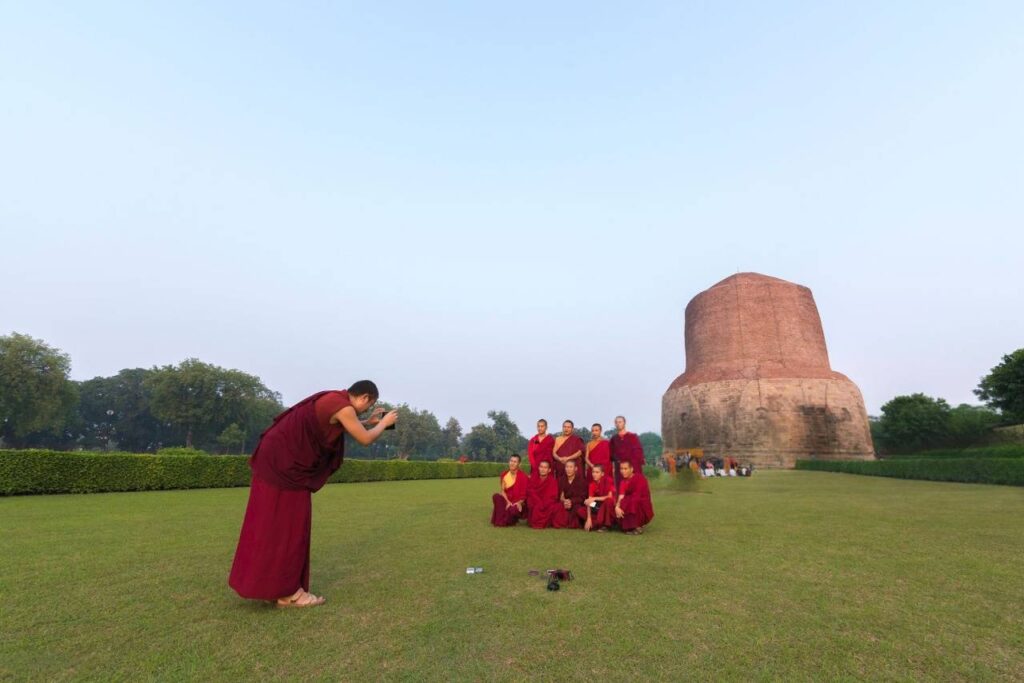Discover Sarnath: A Sacred Blend of History, Peace & Spiritual Awakening
Located just 10 kilometers from the ancient city of Varanasi in Uttar Pradesh, India, Sarnath is a peaceful town that holds a special place in the hearts of Buddhists around the world. It is here that Gautama Buddha gave his first sermon after attaining enlightenment, making Sarnath one of the holiest Buddhist sites. With its rich history, spiritual vibe, and quiet charm, Sarnath offers a perfect escape for those seeking peace, knowledge, and reflection.
A Glimpse into History
Sarnath’s name comes from “Saranganath,” which means “Lord of the Deer.” According to legend, the Buddha chose this location because of its calm and natural surroundings. The site was originally a deer park, and the Buddha wanted to teach in a place where both humans and animals could live in harmony.
More than 2,500 years ago, after attaining enlightenment under the Bodhi tree in Bodh Gaya, the Buddha traveled to Sarnath to share his teachings for the first time. Here, he preached the Dhammacakkappavattana Sutta (The Setting in Motion of the Wheel of Dharma) to his five former companions. This sermon marked the beginning of the Buddhist Sangha (community of monks).
Spiritual Significance
Sarnath is considered one of the four key pilgrimage sites for Buddhists, along with Lumbini (birthplace), Bodh Gaya (enlightenment), and Kushinagar (death). Devotees from across the world visit this sacred site to meditate, offer prayers, and walk in the footsteps of the Buddha.
The town radiates a sense of calmness and inner peace. The sound of monks chanting, prayer flags fluttering in the wind, and the sight of smiling pilgrims in saffron robes create an atmosphere unlike any other.
Must-Visit Attractions in Sarnath
1. Dhamek Stupa
The Dhamek Stupa is the most prominent structure in Sarnath and stands as a powerful symbol of the Buddha’s first sermon. This massive cylindrical tower, made of bricks and stone, was originally built in 249 BCE by Emperor Ashoka and later enlarged. The stupa is beautifully carved with floral and geometric patterns.
Pilgrims walk around the stupa in a clockwise direction, chanting prayers and meditating. The peaceful surroundings make it an ideal place for spiritual reflection.
2. Chaukhandi Stupa
This stupa marks the spot where the Buddha first met his five disciples. The structure was originally a simple brick stupa but was later transformed into its current form with a Mughal-style tower on top. It offers a scenic view of the surrounding area and is often less crowded than Dhamek.
3. Mulagandha Kuti Vihara
Built in the 1930s by the Maha Bodhi Society, this modern Buddhist temple stands near the ruins of the ancient monastery. The Mulagandha Kuti Vihara houses beautiful frescoes depicting scenes from the Buddha’s life, painted by Japanese artist Kosetsu Nosu. It also contains sacred relics of the Buddha and features peaceful gardens and prayer halls.
The temple comes alive during Buddha Purnima, when devotees from many countries gather to celebrate the birth, enlightenment, and death of the Buddha.
4. Sarnath Archaeological Museum
This museum, established in 1910, displays an impressive collection of ancient artifacts found at Sarnath. Its most famous piece is the Lion Capital of Ashoka, which is also the national emblem of India. Other exhibits include statues of the Buddha, inscriptions, coins, and tools from ancient times.
The museum provides a deeper understanding of Sarnath’s role in history and the spread of Buddhism.
5. Ruins of Monasteries and Temples
Scattered around Sarnath are the ruins of ancient monasteries, temples, and stupas that were once part of a thriving Buddhist center. Walking among these remains, you can imagine the spiritual life that once flourished here. The old stone platforms, meditation halls, and prayer spots give a glimpse into early Buddhist architecture and community life.
International Influence and Temples
Over the years, many Buddhist countries have built their own temples and monasteries in Sarnath. These international centers reflect their unique architectural styles and offer a global view of Buddhism. Some notable ones include:
-
Thai Temple – Featuring a golden Buddha statue and lush gardens.
-
Tibetan Monastery – Known for its colorful artwork, large prayer wheels, and vibrant flags.
-
Japanese Temple – Peaceful and minimalist, with a serene meditation hall.
-
Sri Lankan Temple – A popular destination for pilgrims from Sri Lanka, often hosting cultural and religious events.
Visiting these temples allows travelers to witness the diverse expressions of Buddhism from across Asia.
Meditation and Peace
Sarnath is not just about sightseeing—it’s about experiencing inner calm. Many visitors come here to attend meditation retreats or take part in yoga and mindfulness programs. These sessions are usually held in monasteries or spiritual centers and are open to people of all backgrounds.
Even if you’re not attending a retreat, just sitting quietly under a tree or near the stupa can be a deeply spiritual experience.
Local Culture and Cuisine
The area around Sarnath offers a taste of traditional Indian and Buddhist culture. Small stalls sell incense, prayer beads, and books on Buddhism. You can also enjoy simple and delicious vegetarian meals, including lentils, rice, chapatis, and fresh vegetables. Many cafes near the temple areas serve herbal teas and Buddhist-style meals in a peaceful setting.
People in Sarnath are warm and welcoming, happy to share stories about their town’s history and beliefs.
Best Time to Visit
The ideal time to visit Sarnath is from October to March, when the weather is cool and pleasant. Summers can be very hot, while the monsoon season (June–September) brings heavy rains. Visiting during Buddha Purnima (usually in April or May) is a special experience, as the town hosts colorful celebrations, processions, and prayers.
How to Reach Sarnath
Sarnath is well-connected to Varanasi, which is easily accessible by train, road, and air.
-
By Air: The nearest airport is Lal Bahadur Shastri International Airport in Varanasi (about 25 km away).
-
By Train: Varanasi Junction is the main railway station, from where you can take a taxi or auto-rickshaw to Sarnath.
-
By Road: Buses and taxis are available from Varanasi and nearby cities.
Final Thoughts
Sarnath is not just a place on the map—it’s a journey of the soul. Whether you are a follower of Buddhism, a history lover, or simply someone looking for peace in a busy world, Sarnath welcomes you with open arms. It reminds us of the timeless values of compassion, mindfulness, and wisdom that the Buddha taught over two millennia ago.
So, take a break from your routine, breathe in the silence, and let Sarnath guide you toward a deeper connection with yourself and the world around you.
🧳 Looking for more travel inspiration?
Sign up for our blog and visit HeavenLeads for our travel tips, guides, and wonderful stories from India and around the world.
Want to rank higher on search engines and drive more organic traffic? IB Digital Services’ SEO experts are here to optimize your website and boost your online visibility.





